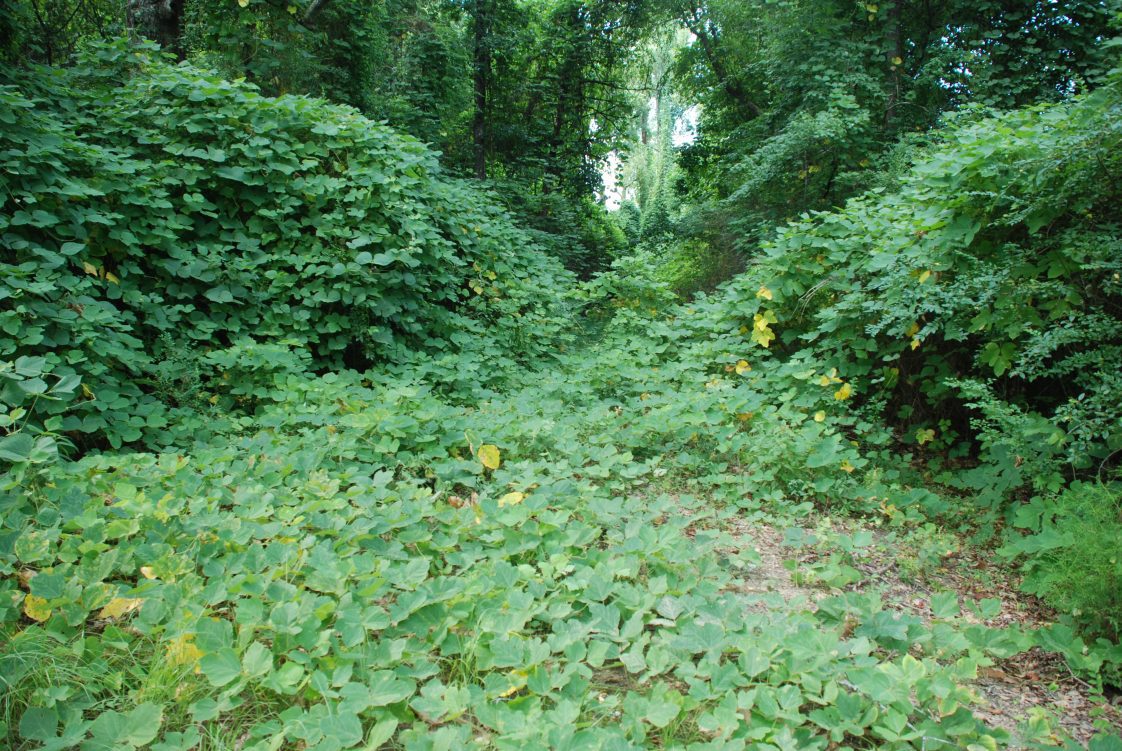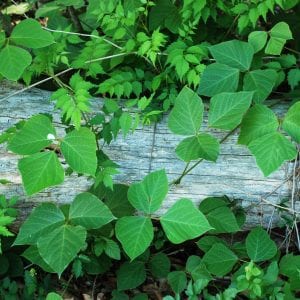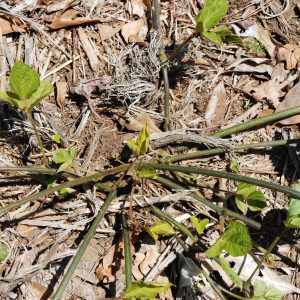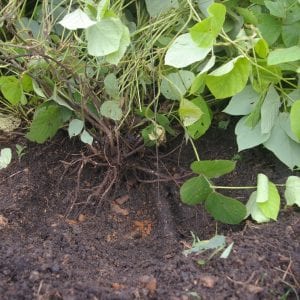Forestry & Wildlife

Kudzu (Pueraria montana) is one of the most widely recognized invasive plants in the southeastern United States. Its aggressive and smothering growth habit makes it a serious weed problem in many environments, including forests, rights-of-way, and natural areas.
Kudzu control is often difficult and may take several years of aggressive treatment, especially for older patches that have persisted for decades.
Q: Will Repeated Mowing or Cutting Work to Remove Kudzu?
Mowing patches of kudzu may be hazardous as dense growth can hide ditches, stumps, fallen logs, rocks, gullies, sinkholes, and virtually anything abandoned in the area to be mowed (figure 1). An additional drawback is that the tough, fibrous vines frequently clog mowing machines. Vines may also persist beneath the mowing height, further increasing the difficulty of control.
In areas where it can be used, repeated mowing that removes more than 80 percent of the leaf area every month of the growing season for a few years can substantially weaken or kill a stand of kudzu. Mowing kudzu along field edges will only provide limited suppression if the vines originate beyond the mowed area.
- Figure 1. Kudzu vines can hide logs, stumps, ditches, and anything abandoned in the area, making mowing hazardous.
- Figure 2. Kudzu root crowns are easiest to spot in the spring when new growth is emerging.
- Figure 3. To stop new kudzu vine growth, cut just below the root crown and remove it from the soil.
Q: I Tried to Dig Up Kudzu and Found a Huge Woody Root. Do I Need to Remove the Whole Root to Stop New Growth?
No, you do not need to remove the whole root. The large root is a storage organ loaded with energy reserves, but it has no ability to sprout. Kudzu grows from seed and root crowns. You can see these root crowns if you follow a vine to where it roots in the soil (figure 2). Dig just a little around it, and you will see several buds, new sprouts, or mature vines emerging from just at or below the soil surface. This is the root crown.
To stop new kudzu vine growth, cut just below the root crown and remove the root crown from the soil (figure 3). Kudzu cannot regrow from below the root crown, and it does not sprout from lateral roots. Sometimes vines may be buried under a few inches of organic matter and leaf litter. This gives them the appearance of lateral roots, but they are not. Buried vines can root, making control more difficult because these hidden vines may produce many new shoots.
Q: What Is the Best Tool to Remove the Root Crowns?
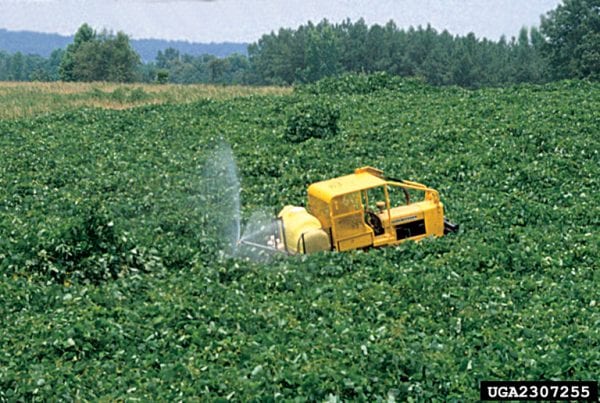
Figure 4. Broadcast spray application can be used on kudzu. (Photo credit: James H. Miller, USDA Forest Service, Bugwood.org)
Use a shovel or pick axe to expose the base of the root crown. Then use a sharp hatchet, mattock, axe, or a small handsaw to cut the root below the root crown. A shovel or hoe is inadequate for the job as the roots are very fibrous or woody. Pruning shears may work for cutting smaller root crowns but will not work for large root crowns. Typically, root crown removal is not practical over a large area, but it may be especially useful for eliminating persistent root crowns following herbicide treatment.
Q: What Herbicide Options Are Available for Kudzu Treatment?
Several herbicides are labeled for kudzu control in rights-of-way, forests, and natural areas (table 1). The use of foliar treatments, either broadcast (figure 4) or spot treatments, is the most common application option for kudzu control in these areas. For homeowner kudzu control, see Alabama Extension publication ANR-2168, “Kudzu Control in Residential Areas,” at www.aces.edu. Except for glyphosate and triclopyr, none of the herbicides in table 1 can be used in homeowner landscape settings as they may damage nearby desirable plants and are not labeled for use in homeowner landscapes. In all situations, always read and follow the herbicide label.
Table 1. Foliar Applied Herbicides Recommended for Kudzu Control in Forests, Rights-of-Way, and Natural Areas
2 See label for specific forestry uses.
3 All products containing picloram are Restricted Use pesticides.
4 Not recommended as a stand-alone broadcast treatment.
5 Only specific glyphosate products are labeled for use in water.
| Herbicide Active Ingredient | Herbicide Name | Broadcast Rate (Product/A) | Spot Treatment Rate | Site Uses |
|---|---|---|---|---|
| Aminocyclopyrachlor + metsulfuron | Streamline | 9.5 to 11.5 oz./A. | 7.5 to 11.5 oz./100 gal. | ROW, natural areas |
| Aminocyclopyrachlor + metsulfuron + imazapyr | Viewpoint | 16 to 20 oz./A. | 13 to 20 oz./100 gal. | ROW, natural areas |
| Aminopyralid | Milestone VM | 7 oz./A. | 7 oz./100 gal. 14 oz./100 gal.1 | ROW, natural areas |
| Aminopyralid + metsulfuron | Opensight | 3.3 oz./A. | 3.3 oz./100 gal. | ROW, natural areas |
| Aminopyralid + triclopyr | Milestone VM Plus, Capstone | 9 pt./A. | 9 pt./100 gal. 9 qt/100 gal.1 | ROW, forests2, natural areas |
| Clopyralid | Transline | 1.33 pt./A. | 21 oz./100 gal. | ROW, forests, natural areas |
| Dicamba + 2,4-D | Veteran 720 | 1 gal./A. | 1 gal./100 gal. | ROW, forests |
| Metsulfuron | Escort, generics | 3 to 4 oz./A. | 3 to 4 oz./100 gal. | ROW, forests, natural areas |
| Picloram + 2,4-D3 | Tordon 101M | 2 gal./A. | 2 gal./100 gal. | ROW, forests |
| Picloram | Tordon K | 0.5 gal./A. | 0.5 gal./100 gal. | ROW, forests |
| Triclopyr ester | Garlon 4 Ultra | 1 to 2 gal./A. | 1.5 gal./100 gal. | ROW, forests, natural areas |
| Triclopyr amine | Garlon 3A | ---4 | 1 to 3 gal./100 gal. | ROW, forests, natural areas, aquatic |
| Glyphosate | Accord Concentrate, others | 0.75 gal./A. | 1.5 gal./100 gal. | ROW, forests, natural areas, aquatic5 |
Q: What Are the Best Options for Kudzu Control in Pine Plantations?
Kudzu control in pine stands may require a multi-herbicide approach because of differences in the tolerance of pine species to labeled herbicides. For site preparation treatments, aminopyralid, aminopyralid + triclopyr, picloram, and metsulfuron are the most effective herbicide options. Residual picloram in the soil can damage pine seedlings. Wait at least 6 months before planting pine seedlings following picloram use. Aminopyralid may cause severe injury if applied to conifer foliage or to the root zone of overstory trees, but it can be used in carefully directed spray applications for conifer release in young conifer stands. This eliminates it as an option if kudzu is growing into the canopy. An exception is longleaf pine, which is more tolerant of aminopyralid, allowing for its use in controlling kudzu infestations in young longleaf. Otherwise, clopyralid is the safest herbicide for kudzu control in canopies of loblolly, longleaf, shortleaf, and slash pine. Metsulfuron can also be used to treat kudzu in loblolly and slash pine, but it is not labeled for use in longleaf or shortleaf pine.
Q: What Is the Best Option on Noncropland and Right-of-Way Sites?
Aminocyclopyrachlor, aminopyralid, clopyralid, metsulfuron, and picloram products are highly effective for kudzu control on noncrop and rights-of-way areas. Read the label carefully, as these herbicides can damage some desirable vegetation.
Q: What Is the Best Option to Treat Kudzu Growing Beside Bodies of Water?
Triclopyr amine and glyphosate are generally weak on kudzu as stand-alone tools. However, they may be useful where kudzu control is required near water as there are triclopyr amine and glyphosate products labeled for aquatic applications. In this setting, the product must be labeled for aquatic use.
Q: What Is the Best Time of Year to Treat Kudzu?
Late summer through early fall is the optimal period for foliar treatment of kudzu. However, treatments may be applied beginning in the early summer. Avoid treating in the spring before leaves have fully expanded. Do not treat severely drought-stressed kudzu or when a hard frost is expected within 2 weeks of treatment.
Q: How Many Herbicide Treatments Will Be Required to Kill Kudzu Completely?
Kudzu root crown age can influence the outcome of herbicide treatment. Young kudzu root crowns can generally be killed with a single treatment. However, older root crowns may require repeated treatments for 3 to 5 years. Another consideration is that kudzu seed may lie dormant in the soil for many years, and these herbicides do not kill dormant seed.
Q: What Is the Best Approach to Control Kudzu Patches Growing on the Edge of Soybean Fields or Other Sensitive Crops?
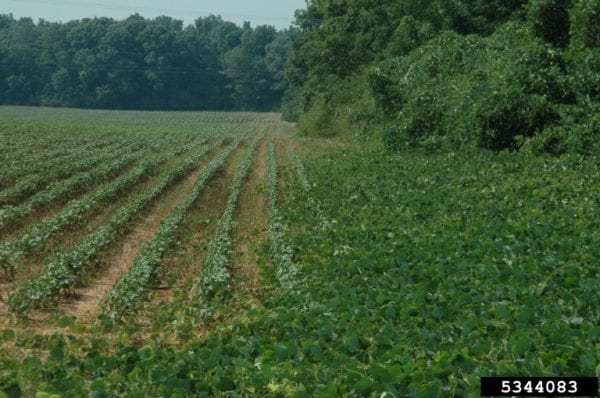
Figure 5. Controlling kudzu growing near sensitive crops can be a challenge. (Photo credit: David Moorhead, University of Georgia, Bugwood.org)
This scenario is sensitive, and great care should be taken when treating kudzu growing near crops (figure 5). For example, every herbicide in table 1 can be lethal to soybeans through drift (all herbicides listed), volatility (triclopyr ester and dicamba), and residual soil activity (aminocyclopyrachlor, aminopyralid, clopyralid, metsulfuron, and picloram). Glyphosate is a safe option for use along field margins of Roundup Ready soybeans at 2.5 to 3.3 quarts per acre. However, the maximum single in-crop application rate is 44 ounces per acre with a total in-crop use of 64 ounces per acre per season. Given that glyphosate is generally weak on kudzu, the low rates used may only provide kudzu suppression. Fencing the kudzu-infested areas and using intensive grazing or repeated mowing are probably the two safest approaches. However, neither will be feasible in many situations.
The bottom line is to always check the label to assess the sensitivity of nearby crops, landscapes, and other desirable plants to the herbicide under consideration for use.
 Nancy J. Loewenstein, Extension Specialist, Forestry and Wildlife Sciences, Auburn University, and Stephen F. Enloe, former Extension Weed Specialist
Nancy J. Loewenstein, Extension Specialist, Forestry and Wildlife Sciences, Auburn University, and Stephen F. Enloe, former Extension Weed Specialist
Revised March 2024, Kudzu Control in Forests, Rights-of-Way & Natural Areas, ANR-2249

